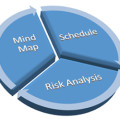
The Project Management Institute’s (PMI) Project Management Body of Knowledge (PMBOK) uses the concept of Project Performance Domains to focus on a holistic view of project performance and outcomes. Eight performance domains provide a comprehensive framework for managing a project from start to finish, and are designed to be adaptable to any project type or industry.
The performance domains are present in every project and run concurrently throughout its life cycle.
In this post, we’ll delve into each of these eight domains, exploring their purpose, components, and how they can impact project success. The eight performance domains are:
- Stakeholders
- Team
- Development Approach and Life Cycle
- Planning
- Project Work
- Delivery
- Measurement
- Uncertainty
1. Stakeholder Performance Domain
Stakeholders are any individuals or groups who can affect or are affected by the project. The Stakeholder Performance Domain emphasizes engaging stakeholders effectively to align their needs with project goals. Key activities in this domain include identifying stakeholders, understanding their expectations, managing communications, and fostering stakeholder involvement throughout the project life cycle.
Why it matters: Misalignment with stakeholders can lead to project setbacks, missed requirements, or conflict. Consistent stakeholder engagement fosters collaboration, minimizes resistance, and ensures that project deliverables align with expectations, leading to smoother transitions and project acceptance.
2. Team Performance Domain
The Team Performance Domain focuses on building and managing an effective project team. This domain covers the formation, development, and management of the project team, ensuring they have the necessary skills, resources, and support to deliver the project. It includes team dynamics, roles and responsibilities, team culture, and motivation.
Why it matters: A well-managed and motivated team is essential for project success. Clear communication, role clarity, and strong leadership ensure that team members are aligned with the project’s objectives and can work cohesively. Fostering a collaborative team culture also encourages innovation, efficiency, and resilience in the face of challenges.
3. Development Approach and Life Cycle Performance Domain
This domain addresses selecting and managing the project’s development approach, whether agile, waterfall, or a hybrid model. It also involves defining the project life cycle stages and phases. The chosen approach impacts planning, scheduling, and risk management, so it must align with project goals and the broader organizational context.
Why it matters: The development approach directly influences how efficiently a project progresses from start to finish. Choosing an approach that aligns with project requirements, such as agile for iterative processes or waterfall for linear projects, ensures better management of resources and timelines, resulting in a more predictable and manageable project workflow.
4. Planning Performance Domain
Planning is the backbone of any project, and the Planning Performance Domain emphasizes creating a realistic and achievable plan for delivering project objectives. This domain covers everything from scope definition to resource planning, schedule creation, budgeting, risk management, and setting quality expectations.
Why it matters: Effective planning is essential for setting clear milestones and defining how success will be measured. A comprehensive plan also provides the project team with a roadmap, helping prevent scope creep, reducing risks, and keeping the project on schedule and within budget. It acts as a reference point throughout the project to ensure consistency and alignment with objectives.
5. Project Work Performance Domain
The Project Work Performance Domain focuses on ensuring the project’s tasks and activities are executed efficiently. It involves the coordination, execution, and monitoring of day-to-day work, aligning resources to accomplish project goals while staying on budget and schedule. This domain also includes adapting plans as needed to address unforeseen changes.
Why it matters: Effective execution ensures that project objectives are being met and that resources are utilized efficiently. Close monitoring of project work allows for quick adjustments to be made when issues arise, helping prevent costly delays or budget overruns. A focus on the day-to-day execution also supports quality assurance, keeping deliverables in line with stakeholder expectations.
6. Delivery Performance Domain
The Delivery Performance Domain revolves around delivering the agreed-upon project outputs. It involves managing the acceptance and transition of deliverables to the client or end-user, ensuring that they meet specified requirements and quality standards. This domain also emphasizes tracking project progress and obtaining acceptance at each stage.
Why it matters: The ultimate goal of any project is to deliver value to the client or end-user. By focusing on delivery, project managers ensure that all outputs align with the defined scope and requirements. Successful delivery fosters client satisfaction, as it demonstrates that the project has met or exceeded their expectations, paving the way for future collaborations or project extensions.
7. Measurement Performance Domain
The Measurement Performance Domain focuses on measuring and evaluating project performance and progress. It involves defining key performance indicators (KPIs), tracking metrics such as time, cost, and quality, and using these metrics to make informed decisions. Regular evaluation helps project managers identify potential issues early and course-correct as needed.
Why it matters: Measurement is vital for maintaining control over a project. By consistently tracking progress and performance metrics, project managers gain insight into whether the project is on track or if adjustments are necessary. Measurement also provides accountability and a basis for reporting to stakeholders, ensuring transparency throughout the project lifecycle.
8. Uncertainty Performance Domain
The Uncertainty Performance Domain addresses the inherent risks and uncertainties in any project. It involves identifying, assessing, and managing risks to mitigate their impact on project objectives. This domain encourages a proactive approach to risk management, which includes contingency planning, monitoring, and adapting to new risks as they arise.
Why it matters: Uncertainty can lead to unforeseen delays, costs, or changes in scope. By actively managing risks, project teams can minimize the negative impact of unexpected events. Anticipating potential disruptions and planning responses enhances resilience, enabling the team to respond swiftly and effectively to any issues that arise during the project.
The Eight Domains are Integrated
While each performance domain has distinct characteristics, they are all interrelated and should be managed cohesively. The effectiveness of a project manager lies in balancing these domains to adapt to the unique challenges of each project. For example, a strong plan (Planning Performance Domain) can only be effective if the team (Team Performance Domain) is motivated and equipped to execute it. Likewise, understanding stakeholder needs (Stakeholder Performance Domain) directly influences what the project delivers (Delivery Performance Domain).
Project managers should also remain flexible in applying these domains, as project conditions often change. As new stakeholders join, unforeseen risks emerge, or shifts in project scope arise, a manager’s ability to adjust across multiple domains becomes critical.
Conclusion
The PMBOK’s eight Project Performance Domains provide a modernized approach to project management, focusing on adaptability and results over strict process adherence. By prioritizing these domains, project managers can foster stronger stakeholder relationships, build cohesive teams, manage risk effectively, and ensure that projects deliver real value. This shift in focus represents an evolution in project management, one that empowers managers to be strategic leaders who guide projects toward success in today’s complex, fast-paced environments.
By embracing these performance domains, organizations and project managers alike can drive more successful outcomes, foster stakeholder satisfaction, and adapt to the demands of modern project landscapes.











Leave a Reply